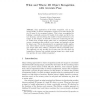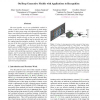16 search results - page 1 / 4 » What is the Best Multi-Stage Architecture for Object Recogni... |
ICCV
2009
IEEE
14 years 9 months ago
2009
IEEE
In many recent object recognition systems, feature extraction
stages are generally composed of a filter bank, a
non-linear transformation, and some sort of feature pooling
layer...
CLOR
2006
13 years 8 months ago
2006
Abstract. Many applications of 3D object recognition, such as augmented reality or robotic manipulation, require an accurate solution for the 3D pose of the recognized objects. Thi...
TROB
2011
12 years 11 months ago
2011
—We study the problem of actively searching for an object in a 3D environment under the constraint of a maximum search time, using a visually guided humanoid robot with twentysix...
MCS
2010
Springer
13 years 3 months ago
2010
Springer
Many different constructions for (t, m, s)-nets and (t, s)-sequences are known today. Propagation rules as well as connections to other mathematical objects make it difficult to ...
CVPR
2011
IEEE
13 years 1 months ago
2011
IEEE
The most popular way to use probabilistic models in vision is first to extract some descriptors of small image patches or object parts using well-engineered features, and then to...


